Views: 635
Tour № 1 – Šventaragis Valley

- Cathedral Basilica of St. Stanislaus & St. Vladislaus
- Cathedral Basilica of St. Stanislaus & St. Vladislaus (inside, including the Chapel of St. Casimir, the Chapel of Deportees, the Gasztołd Chapel, the Royal Chapel, St. Wladislaw/Vladislaus/Ladislav Chapel, High alter, Memorial plague to the Grand Duke of Lithuania Vytautas Magnus, the Sapieha Madona’s picture, etc)
- Cathedral Basilica Bell Tower
- Royal Palace of Lithuania (the Palace of Grand Dukes of the Grand Duchy of Lithuania)
- Upper Castle
- Upper Castle’s West (Gediminas) Tower
- Old Arsenal – Museum of Applied Art
- New Arsenal – Lithuanian National Museum
- Monument to King Mindaugas (1236-1263: Crowned King on July 6th, 1253)
- Monument to Lithuanian Grand Duke Gediminas (1316-1341: the founder of Gediminian-Jagiellonian ruling dynasty)
Tour № 2 – Vilnius University & Monastery Quarter

- Vilnius University – Historical Campus (est. 1579)
- Vilnius University – the Bronze door of the Central Library
- Vilnius University – Historical Campus (inside, including 12 university’s courtyards, Domus Philologiae, Smuglevičius Hall, White (Observatory) Hall, Lelewel Hall, Lithuanian Philology Centre, etc)
- Vilnius University – Science Museum
- St. Johns’ Church in the Great (Skarga) university’s Courtyard
- St. Johns’ Church in the Great (Skarga) university’s Courtyard (inside, including Great alter, Altar of Maria of Loretto, Chapel of St. Anne, Altar of St. Victorino, Organ, several memorial plagues and frescos, etc)
- St. Johns’ Church in the Great (Skarga) university’s Courtyard – Bell Tower
- Dominican Street
- University Street
- St. John Street
- Church of the Holy Cross and former Hospitaller Monastery
- Monument to Laurinas Gucevičius (1753-1798)
- Presidential Palace (Prezidentura)
- Alumni (Alumnatas) Courtyard
- Sanctuary of Divine Mercy
- Church of the Holy Spirit and former Dominican Monastery
- St. Ignatius Church and former Jesuit novitiate
- Plaque for Righteous Among the Nations
- Monument to Stanislaw Moniuszko (1819-1872)
- St. Catherine’s Church and former Benedictine Monastery
Tour № 3 – From the Cathedral Basilica to Town Hall Square
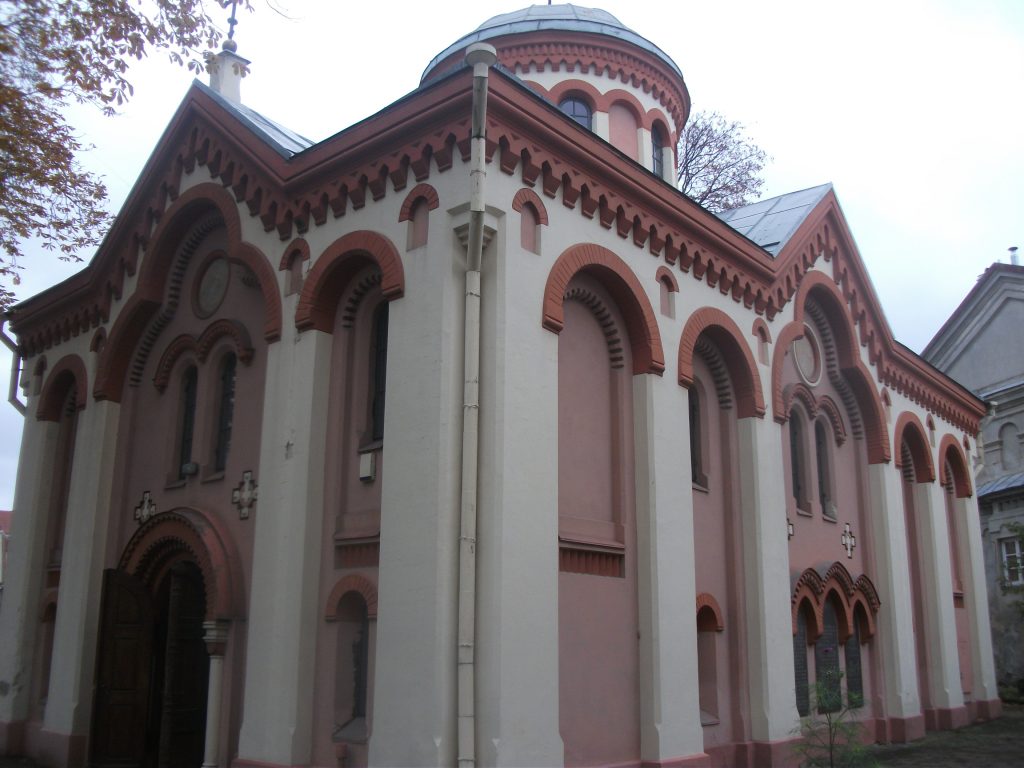
- Buildings of Pilies Street
- House of the Signatories
- Marija and Jurgis Šlapelis House Museum
- Paraskeva Russian Orthodox Church
- Pilies Street souvenir open market – What should you buy in Vilnius
- Buildings of Didžioji (Great) Street
- Vilnius Picture Gallery (Chodkiewicz Palace)
- Stendhal House
- Nicholas Russian Orthodox Church
- Historical Town Hall
- Buildings around the Square of Historical Town Hall
- Former printing house of Francysk Skaryna (1486-1551) – the Magistrate House
- Buildings of Savičiaus Street
- Mikalojus Konstantinas Čiurlionis’ (1875-1911) Memorial Flat Museum
- Church of Blessed Mary the Comforter and the Augustine Monastery
- Kazys Varnelis’ (1917-2010) House Museum – Great and Small Guilds
- Casimir Church
- Buildings of Subačius Street
- Bastion – an artillery fortification
- Church of the Assumption and former Missionary Monastery
Tour № 4 – Quarter of Three Confessions
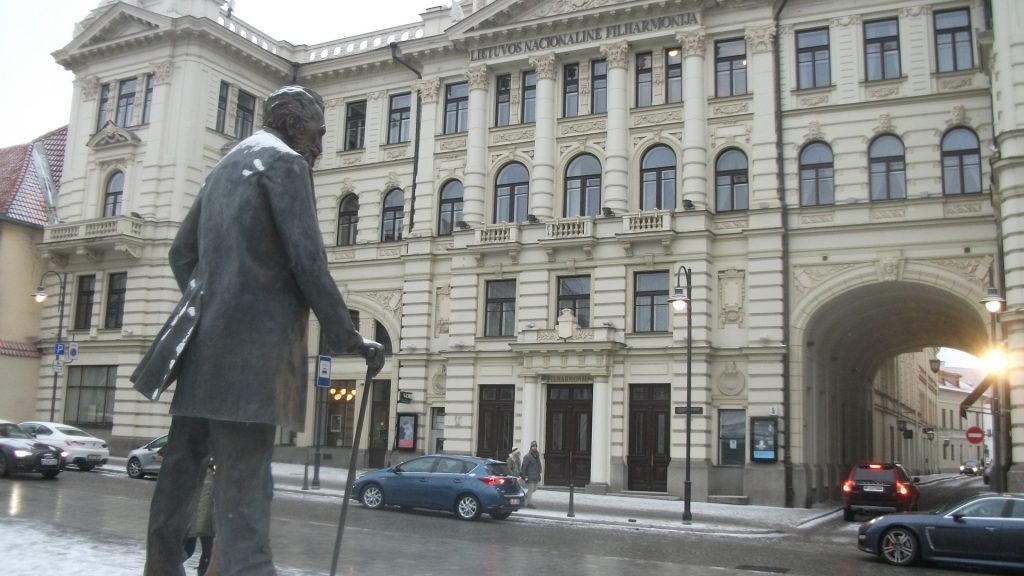
- Buildings of Aušros Street
- Radisson SAS Astorijos Hotel (former Italia hotel)
- Building of National Philharmonic
- Monument to Jonas Basanavičius (1851-1927) on the square in front of National Philharmonic
- Memorial plaque to Ignacy Domeyko (1802-1889)
- Baroque gate to Uniate Church of the Holy Trinity and former Basilian Monastery
- Uniate Church of the Holy Trinity and former Basilian Monastery
- Memorial plaque to Josaphat Kuncevic (St. Josaphat, 1580-1623)
- Memorial plaque on the building of former Basilian Monastery where Adam Mickiewicz (1798-1855) was imprisoned
- Russian Orthodox Church of the Holy Spirit and monastery
- Russian Orthodox Church of the Holy Spirit (inside, including the remains of the Three Vilnius Martyrs kept under a wooden canopy in front of the iconostasis)
- Church of St. Teresa (of Ávila, Spain) and former Carmelite Monastery
- Church of St. Teresa (of Ávila, Spain) (inside, including the church’s mural paintings, the Chapel of Pac’s family’s mausoleum, impressive, gently-curved church’s pulpit and the altar)
- Chapel of the Gate of Dawn (Medininkų Gate)
- The sacred picture of the Holy Virgin Mary in the Chapel of the Gate of Dawn (Medininkų Gate)
- Votive objects in the Chapel of the Gate of Dawn (Medininkų Gate)
- The Gate of Dawn (Medininkų Gate) from the southern side with a Renaissance composition of Vytis
Tour № 5 – Jewish Quarter
- Small and Large Vilnius Jewish Ghettos
- Monument to the Vilna Gaon
- Mark Antokolski (1840-1902) House
- Former Mattityahu Strashun (1817-1885) Jewish Library
- Vokiečių gatvė (German Street)
- Contemporary Art Centre
- „Barbara“ sculpture
- Monument in remembrance of Vilnius Ghetto martyrs and fighters in 1941-1943
- Church of St. Nicholas
- A sculpture of Vilnius Patron Saint Christopher in the yard of the Church of St. Nicholas
- Evangelical Lutheran Church
- Amatų gildija (Artisan guild) open ceramic workshop and gallery
- Former Vilnius ghetto theatre 1941-1943
- Former Gothic façade at Karmelitų gatvę (Carmelite Street)
- Closed courtyards with open galleries, characteristic of Old Town architecture
- Church of All Saints and former Carmelite Monastery
- A section of Vilnius historical defensive wall
- The sculpture named „Egg“
- Monument to Tzemach Shabad (1864-1935)
- Choral Synagogue
- Church of the Assumption of the Holy Virgin Mary and former Franciscan Monastery
- Sculpture of the Holy Virgin Mary (The White Mother of God)
- Suzin’s built Baroque-style family mausoleum chapel
- A monument to Jozef Montwiłł (1850-1911)

Tour № 6 – Bends of the River Vilnia
- Adam Mickiewicz’s Memorial Flat Museum
- Church of St. Anne
- Church of St. Francis and St. Bernardine
- Chapel of the Holy Steps
- Monument to Adam Mickiewicz
- Church of St. Michael the Archangel
- Adam Mickiewitz’s House
- Sereikiškių Park
- Amber Museum
- Russian Orthodox Church of the Blessed Mother of God
- „Angel of Užupis“ sculpture
- Constitution of the „Republic of Užupis“
- Church of St. Bartholomew
- Bernardinų Cemetery
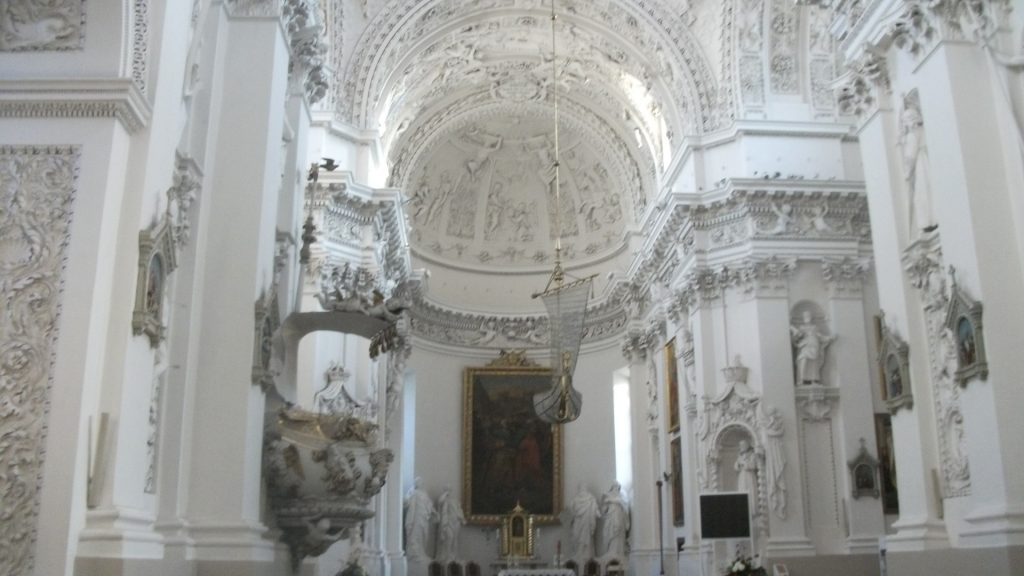
Tour № 7 – City Centre
- Three Crosses Monument on the Three Crosses Hill
- Church of St. Peter and St. Paul
- Petras Vileišis Estate
- Tuskulėnų Park with columbarium
- A building of Lithuanian Energy
- A building of Lithuanian Theatre, Music and Film (A Small Radziwiłł Palace)
- A Great Radziwiłł Palace
- Vilna Gaon Jewish State Museum
- Sculpture or Roman Gary
- A monument to Frank Zappa
- Museum of Genocide Victims (former KGB Headquarters)
- A plaque to Chiune Sugihara
All photos are copyrighted by Vladislav B. Sotirovic
© Vladislav B. Sotirovic 2018

RELATED POSTS
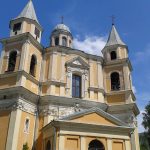
The interior sculptural décor was created by Pietro Perti (Italian master) in 1700-1705. Twin towers were built on in the 18th century. It was built by the efforts of Casimir Sapieha the Younger (1637-1720) in 1694-1717 On the façade frieze two Christian soldiers taken into captivity by the Muslims are represented. The main goal of the Trinitarian Order was returning such captives to their homelands The church has an impressive cupola (dome), the interior is adorned with stucco relief works and sculptures - a large part of them is survived. The church is a "sister" to the Church of St. Peter and St Paul in Vilnius (Antakalnis)All photos are copyrighted by Vladislav B. Sotirovic© Vladislav B. Sotirovic 2019
Continue Reading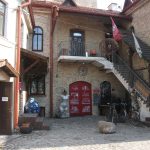
Užupio street is the main street in the city's district of Užupis. The district was in the Soviet time one of the most dilapidated districts in Vilnius. Many of the buildings did not have electricity and sanitary facilities, and the streets were unlitThe River Užupis which separates Užupis district from the Old Town. On one side of the river is a unique ensemble of sacred buildings and a park, while on the other side is "Republic of Užupis", where a number of artists live and work"Angel of Užupis" sculpture. An angel is playing a trumpet that provides ideas about Užupis to others and protects the district. The 24th Article of the Constitution of Užupis, for instance, says that "Everyone has the right to understand nothing". The district is separated from the Old Town by the River Vilnia on three sides, and by a high hill on the fourth sideAll photos ...
Continue Reading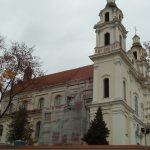
The church is an elegant late Baroque monument built-in 1702-1730. It is made even more attractive by an asymmetrical monastery ensemble in 1713-1730The towers date from the mid-18th century. They end in rococo domes with lanterns Both the church and the monastery belonged to the Jesuit Order. The monastery was intended for the Jesuit monks with 10 years of service experience seeking to become professed Jesiuts, i.e., to make the last ceremonial vowes All photos are copyrighted by Vladislav B. Sotirovic© Vladislav B. Sotirovic 2019
Continue Reading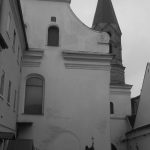
This is the first Evangelical Lutheran Church (Kirche) built-in Vilnius in 1555 on the initiative of the Chancellor of the Grand Duchy of Lithuania Nicholas Radziwiłł the Black. In front of the church, there is a monument erected to Martin Luther The church was rebuilt in 1662 and substantially reconstructed in 1738-1744. In 1944 it was closed down. In 1993 it was returned to the parishioners and renovatedThe church has a single nave and an original pentagonal shape. Its magnificent high altar was designed by German Protestant architect Jan (Johan) Krzysztof GlaubitzAll photos are copyrighted by Vladislav B. Sotirovic© Vladislav B. Sotirovic 2019
Continue Reading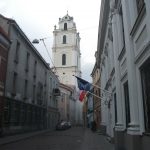
In this street, it was used to be a market place where it meets Pilies street. The first Town Hall is also believed to have stood on this spot Pharmacy house in St. John St. No. 5. Georg Schulz's pharmacy operated in this house since 1639. During the war in 1655, the house was burned down. In 1781, pharmacist Koszyk acquired the ruined building and reconstructed it The Pac estate. Since 1628, the building belonged to the Pac magnate family of the Grand Duchy of Lithuania. In 1783, the dilapidated building was bought, renovated and decorated by the Chancellor of the Grand Duchy of Lithuania - Alexander Michael Sapieha. Currently, the building belongs to the Polish Embassy All photos are copyrighted by Vladislav B. Sotirovic© Vladislav B. Sotirovic 2020
Continue Reading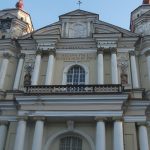
The founder of the church was a Grand Hetman and Vilnius Voivode of the Grand Duchy of Lithuania. The 17th-century church's façade is modest, however the interior is richly ornate with a number of stucco mouldings The church was built to mark the liberation of Vilnius from Moscow (The 1655-1661 War) and the founder's own escape from the hands of rebellious soldiers. The interior was created by the Italians G. P. Perti and G. M. Galli, who decorated it with more than 2,000 stucco mouldings The chandelier was created in 1905 in Riga and represents the Biblical Noah's arkAll photos are copyrighted by Vladislav B. Sotirovic© Vladislav B. Sotirovic 2018
Continue Reading
Town Hall Square has been a market place since very early times, and it today dominated by the Town Hall which was formerly a court, with the basement being used as prison cellsThe Town Hall back-side. The present building was constructed between 1785 and 1799 by the Classical architect Lithuanian Laurynas Stuoka-Gucevičius The square in front of the Town Hall is the venue for an annual three-day crafts market on the weekend closest to March 4th, St. Casimir's DayAll photos are copyrighted by Vladislav B. Sotirovic© Vladislav B. Sotirovic 2020
Continue Reading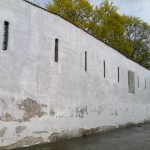
It was not until 1503 when Grand Duke of Lithuania and King of Poland Alexander Jagiellon granted a privilege that the construction of the wall began. The year 1522 is considered to mark the end of the construction, when Grand Duke of Lithuania Sigismund the Old exempted the residents of Vilnius from the duty of keeping guard at the castle and ordered 24 guards to be posted at the city gatesThe length of the defensive wall was 2,5 kilometres having 10 gates. The wall surrounded the territory of today's Old Town, approximatelly 100 hectars. The foundation of the defensive wall was built of stone, and bricks were mainly used at the level of loopholes and higher. The was was adapted for defence with gunpoweder-operated firearms Until the late-18th century, the Vilnius defensive wall was frequently renovated. The wall served for the last time in 1794 during the uprising led by ...
Continue Reading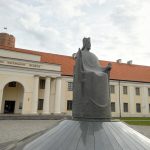
Originally, the Vilnius Lower Castle's jurisdictional court and administration was housed in this building during the 17th and 18th centuries. In the 18th century it was reconstructed into a weapons store-house and militarry baracks. Today, the museum holds the most important archaeological, historical, and ethnic cultural collections of Lithuania that cover Lithuania's history from the Stone Age to the present-day. In front of the building is a monument to King Mindaugas In 2003, a monument to King Mindaugas was erected in the square in front of the building of New Arsenal (today Lithuanian National Museum)In the 19th century, an entrance in the Classical style was biultAll photos are copyrighted by Vladislav B. Sotirovic© Vladislav B. Sotirovic 2018
Continue Reading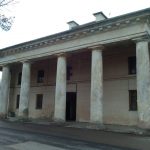
In 1780, Vilnius Bishop Ignacy Massalski settled in Verkiai. He commissioned Lithuanian architect Laurynas Gucevičius to reconstruct an earlier palace. The general plan and maintenance buildings were designed by Lithuanian architect Martin KnackfussThe ensemble encompasses the park of 36 ha. Situated on two terraces, the park consisted of two parts - the upper and the great park. A view of Vilnius and the Neris River is exposed from a steep slopeSince 1960 the ensemble belongs to the Lithuanian Academy of Science and is gradually renovatedAll photos are copyrighted by Vladislav B. Sotirovic© Vladislav B. Sotirovic 2021
Continue Reading
The life and work of Dr. Jurgis and Marija Šlapelis reflects the life of the region of Vilnius from the second half of the 19th century to 1940. Both of them have been cultural figures in Lithuania. Marija was actress. They published Lithuanian books that were banned at that timeDr. Jurgis and Marija Šlapelis owned the only Lithuanian language bookstore in Vilnius during 1906-1949. The Šlapelis family bought the house in 1926. Before, it was a goldsmith's workshops, and later housed a small holet called the Hotel de Philadelphie, and a wine shop The building is an example of the 17-th century architecture. Dr. Jurgis died in 1941, and Marija in 1977 at the age of 97. After WWII, the house was nationalised, and, therefore, Marija Šlapelis was forced to live in two small rooms upstairs, with the only access to them through another person's quarters. Marija stipulated in her ...
Continue Reading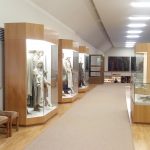
The museum is located in the north wing of the Old Arsenal and looks at Neolithic, Bronze and Iron Age Lithuania followed by the various tribes that inhabited the area until they combined to form a state in the 13th centuryThe museum displays object found in burial sites, such as pins, amulets, rings, brooches, knives or necklaces. You can as well as see regional dressses of Lithuanian tribes before the formation of the state in the mid-13th century The museum shows a hoard of some 16.000 17th-century coins found in 1999 in Vilnius. It is believed that the hoard may have been hidden during the 1700-1721 Great Northen War. Nevertheless, it is the largest collection of old coins to be found in Lithuania All photos are copyrighted by Vladislav B. Sotirovic© Vladislav B. Sotirovic 2020
Continue Reading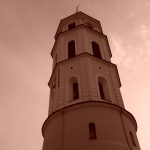
Its foundations are superimposed on the remains of a square tower, one of the oldest brick buildings in Lithuania, whose bricks are bound in the pre-Cothis (Baltic) manner An oval four-story tower with loopholes was built on these remains. Originally, it was a defensive tower of the Lower CastleThe underground square part dates from the 13th century, and the round part - from the late 14th century All photos are copyrighted by Vladislav B. Sotirovic© Vladislav B. Sotirovic 2019
Continue Reading
According to legend, the monastery and wooden church were built circa 1332 in the burial spot of the Franciscan monks that had been martyred by Lithuanian pagansThe building complex is formed in the mid-18th century. Today, the church possess six Late Baroque-style altars, with the main altar having a picture of the Holy Virgin Mary that is considered to be miraculous. A copy of the picture is painted on the façade in 1742 The monument to famous Lithuanian neo-Classicist architect Laurinas Gucevičius, the founder of Vilnius neo-Classicism, is erected in 1994 in the square in front of the church. All photos are copyrighted by Vladislav B. Sotirovic© Vladislav B. Sotirovic 2020
Continue Reading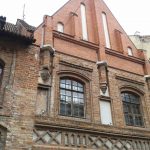
There were formerly two separate Gothic houses. Both were built before 1514 and belonged to clergy, goldsmiths, a surgeon and pharmacists. During the 1655-1661 war with Russia they were damaged and handed over to the capitulary of the Cathedral, which had them rebuilt in the Baroque styleThe building were severely damaged during the Second World War and renovated in 1957-1960Decorative Gothic façades and cylindrical vaults in the basement and on the ground floor have been reconstructed All photos are copyrighted by Vladislav B. Sotirovic© Vladislav B. Sotirovic 2019
Continue Reading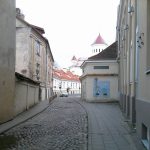
The Grand Duke of Lithuania Sigismund (1432-1440), who ruled briefly after the death of his brother Vytautas the Great (died in 1430), granted equal rights to the Russian Orthodox believers living in the capital-city of Vilnius - before long they came to constitute one half of the members of the city board and guild elders In the Middle Ages Vilnius (today Old Town) was increasingly multy-national as it was the case with the Grand Duchy of Lithuania as well. The city was, in fact, divided into four quarters according to the ethnic and religious belonging of its citizens: the German Quarter, the Russian Quarter, the Jewish Quarter, and the Tartar Quarter. Each of these city quarters had the main street named according to the ethnic belonging of their inhabitantsThe Russian Street in Old Town of Vilnius ends with the Russian Orthodox Cathedral (Sobor) of the Dormition of the Holy Mother ...
Continue Reading
The Old Campus in the Old town - Rectorate building. On April 1st, 1579 the King of Poland and Grand Duke of Lithuania Stephen Bathory issues a royal charter recognizing the Jesuit College into a universityThe Old Campus in the Old town - Rector's Office and former Astronomical Observatory building (right) and the Central Library building (left) with the Central Library Courtyard in front of the buildingsThe History Facutly building (left) and the Central Library building (right) with the arched gates to Mikalojus Dukša Courtyard (left) and Mathias Casimir Sarbievius Courtyard (forward). The Old Campus of the university has 13 courtyardsAll photos are copyrighted by Vladislav B. Sotirovic© Vladislav B. Sotirovic 2018
Continue Reading
Mindaugas Bridge is constructed in 2003. It has the name of the only Lithuanian King crowned on July 6th, 1253On the foothill on the left riverside of Neris, there is a Renaissance building of Old Arsenal followed by the buildings of House of the Castle Keeper and New Arsenal On the right riverside of Neris, a new business center of Vilnius is growing during the last two decadesAll photos are copyrighted by Vladislav B. Sotirovic© Vladislav B. Sotirovic 2019
Continue Reading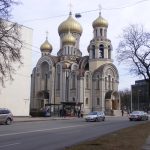
It is one of the most attractive Russian Orthodox churches in Vilnius: the exterior is a profusion of shining onion-shape domes; but the interior is remarkably serene. The interior's simplicity is interupted only by an elaborate iconostasis The internal space is created by two huge pairs of parallel semi-circular arches, intersecting at the top under the central dome which is also the main source of lightA panel on the right of the iconostatis depicts the two saints, both from noble families in the Middle Ages, to whom the church is dedicatedAll photos are copyrighted by Vladislav B. Sotirovic© Vladislav B. Sotirovic 2020
Continue Reading
The Górecki estate in Dominikonų St. 15 is a two-storey Gothic house. It was built on this site in the late 15th or early 16th century. In 1649 it was bought by Vilnius UniversityZawisha estate is known since late 16th or early 17th century. It was renovated in the late 18th century. The façade is strictly symmetrical, done in the style of early Classicism. Renaissance vaults have survivedDominikonų Street is dominated by the Roman Catholic Church of the Holy Spirit and the Dominican Monastery (1501)All photos are copyrighted by Vladislav B. Sotirovic© Vladislav B. Sotirovic 2020
Continue ReadingChurch of Our Lord Jesus and the Trinitarian Monastery
“Republic of Užupis”
Church of St. Archangel Raphael
Evangelical Lutheran Church
St. John Steet in Vilnius
Church of St. Peter and St. Paul in Vilnius
Around Town Hall Square in Vilnius
The Defensive Wall of Vilnius
Lithuanian National Museum (New Arsenal) and a Monument to King Mindaugas
The Ensemble of the Verkiai Estate
The Šlapelis House Museum
The Museum of Archaeology of Lithuania
The Belfry of the Cathedral Basilica in Vilnius
Church of the Holy Cross & former Hospitaller Monastery
Gothic Brick Architecture in Vilnius: Pilies (Castle) Str.
The Russian Street in Vilnius
Vilnius University Est. 1579
Vilnius Panorama of the Neris River
The Russian Orthodox Church of St. Michael and St. Constantine
Dominikonų Street in Vilnius



